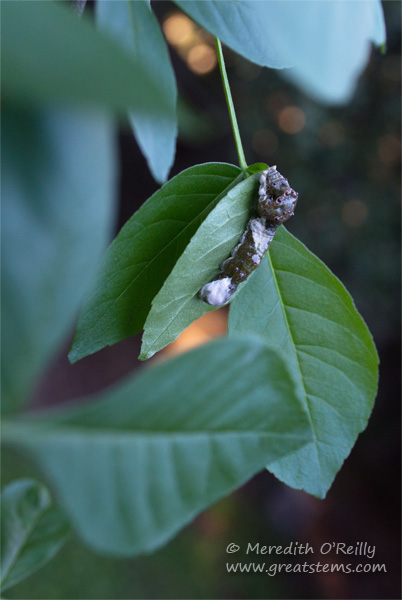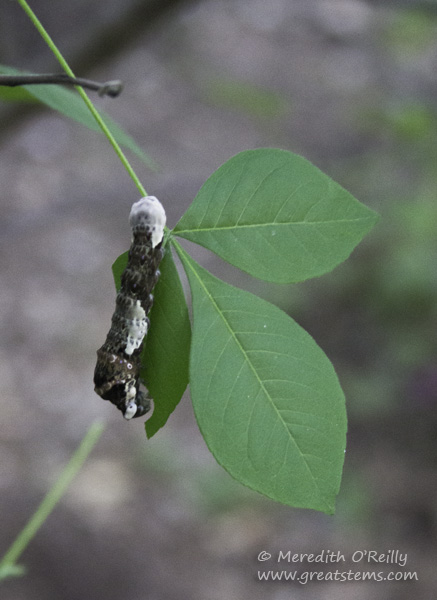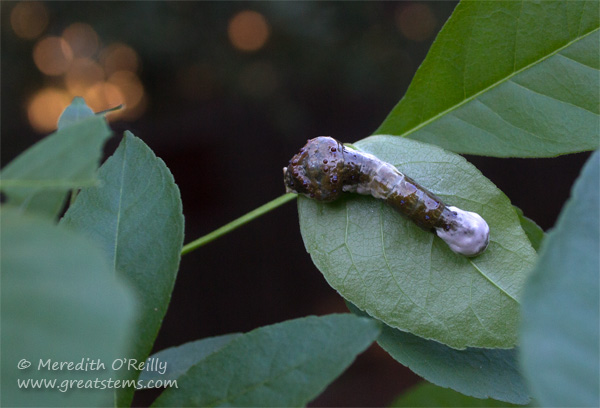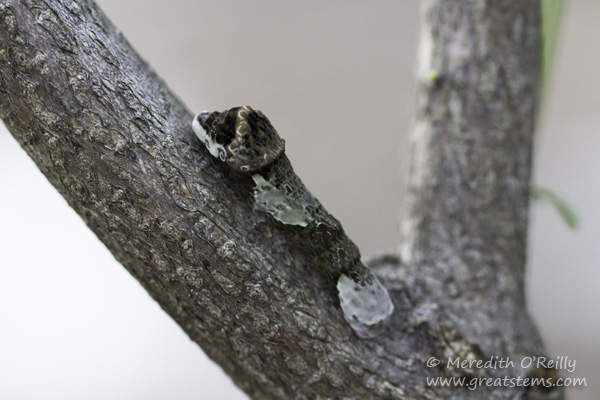A few years ago, in the early stages of my wildlife garden, I planted my first Wafer Ash, or Common Hop Tree (Ptelea trifoliata). I was ecstatic about it, because I longed for Giant Swallowtail caterpillars to call it home (and dinner). These fun caterpillars are known for their characteristic bird-poop appearance, but the adult Giant Swallowtail stage is also spectacular — a gorgeous and very large yellow-and-black butterfly.
 This year we had to transplant that now large Wafer Ash to the opposite side of the yard, and I feared that it wouldn’t survive. But amazingly enough it did, and we have our latest batch of bird-poop caterpillars. These little guys are making me so happy, and I really do feel at the moment like the garden has come full circle — I’m right back to seeing one the favorite fauna species I planted trees for all those years ago.
This year we had to transplant that now large Wafer Ash to the opposite side of the yard, and I feared that it wouldn’t survive. But amazingly enough it did, and we have our latest batch of bird-poop caterpillars. These little guys are making me so happy, and I really do feel at the moment like the garden has come full circle — I’m right back to seeing one the favorite fauna species I planted trees for all those years ago.
 Wafer Ash is a small deciduous tree found in much of the eastern and southern areas of the United States and into Central America. Because it prefers part shade to shade for its light, it serves well as an understory tree. It earned its species name trifoliata for its characteristic three leaflets. Small white flowers in late spring give rise to wafer-like seeds come fall, hence one of its common names.
Wafer Ash is a small deciduous tree found in much of the eastern and southern areas of the United States and into Central America. Because it prefers part shade to shade for its light, it serves well as an understory tree. It earned its species name trifoliata for its characteristic three leaflets. Small white flowers in late spring give rise to wafer-like seeds come fall, hence one of its common names.

But Wafer Ash is not actually in the ash family at all — it’s actually part of the citrus family. In fact, lemon, orange, and other citrus trees can sometimes host these little caterpillars, too. I’ve definitely noticed that they much prefer the more tender leaves — I wonder whether the female butterfly actually selects them that way. In the wild, I can’t ever seem to find caterpillars on hop trees with bigger, darker leaves.
 When these caterpillars take a rest, they are often found along the bark or branches of the tree, perhaps for camouflage or to simply avoid predators that might more easily locate them on the green leaves. As if that bird poop appearance isn’t enough to deter would-be munchers!
When these caterpillars take a rest, they are often found along the bark or branches of the tree, perhaps for camouflage or to simply avoid predators that might more easily locate them on the green leaves. As if that bird poop appearance isn’t enough to deter would-be munchers!
Giant Swallowtails are, indeed, nifty aren’t they? I saw my first one (and then repeated) visits this summer. My heart was racing I was so excited. They’re gigantic! We have Common Hop trees in the southern part of Wisconsin, too, but we’re at the northern most edge of its range. What seemed to attract the Giant Swallowtails to my garden was the blooming Swamp Milkweed and the tropical annuals–Lantana, Cosmos, and Zinnias. I also found two of the cats on a Prickly Ash when we were hiking. That was very exciting, too! Great post!
Beth, I get super excited when I find the cats, too, because they just aren’t as common as, say, Black Swallowtails that love dill and parsley. But they are gorgeous — I love to raise them.
What a fascinating tree and I love the name and look of these caterpillars….they almost look like lichen on the tree.
Yep, Donna. Nature and camouflage — so cool.
I love those trees also. I first met a little grove of them when I lived in Dripping Springs. I collected seeds and grew some for myself. I ended up with lots of babies and donated the extra ones – after I’d planted a few on my daughter’s property – to the Lady Bird Johnson Wildflower Center for their fall sale. Hopefully they have all hosted swallowtails.
I love that you donated some of them to the Wildflower Center, Marilyn. I should grow some plants for them, too.
We may have to remove a tree this year, and a shade loving wafer ash sounds like the ideal replacement. I already grow several kinds of citrus for the Giant Swallowtails, but the idea of this tree really appeals to me.
I do love Wafer Ash, Vicki. I find its airy appearance delightful. You should definitely consider it!
Where did you get your wafer ash, Meredith? I’d love to have one, too!